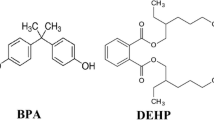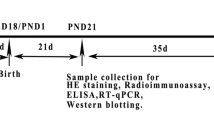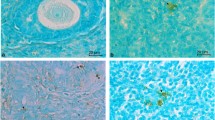Abstract
To study the alleviating effects of flavonoids from Cuscuta chinensis (CCFs) on ovary injury in female offspring of pregnant mice exposed to BPA, five groups (n = 20) of pregnant mice were intragastrically administrated with BPA (5 mg/kg/day) and CCFs (20 mg/kg/day, 30 mg/kg/day, 40 mg/kg/day) at pregnancy days 1–18. The ovaries and serum of F1 female mice were collected at postnatal day (PND) 21 and PND 56 for the detection of related indicators. The ovarian and testicular histomorphologies were observed with hematoxylin-eosin staining (H&E). The levels of follicle-stimulating hormone (FSH) and luteinizing hormone (LH) and the contents of estradiol (E2), progesterone (P4), and testosterone (T) in serum were detected by radioimmunoassay. The contents of ovarian and testicular estrogen receptor alpha (ERα) and estrogen receptor beta (ERβ) were detected by enzyme-linked immunosorbent assay (ELISA). The expression of caspase-7, caspase-9, bcl-2, and bax in ovaries and testes of offspring mice were detected by Western blot, and apoptosis in ovaries and testes was detected by TUNEL. The mRNA relative transcription levels of ERα, progesterone receptor (PgR), DNA methyltransferase1 (Dnmt1), DNA methyltransferase3A (Dnmt3A), and DNA methyltransferase3B (Dnmt3B) were detected by real-time quantitative PCR (RT-qPCR). The ovary of female offspring with PND 56 was treated with bisulfite sequence PCR (BSP). Our results showed that, compared with the BPA group, 40 mg/kg CCFs significantly reduced the ovarian index of F1 females and the ovarian cytoapoptosis (P < 0.01). CCFs also can alleviate the injure of the levels of serum hormone, hormone receptors, and DNMTs induced by BPA in F1 females at PND 21 and PND 56. Forty milligrams per kilogram of CCFs significantly inhibited the hypermethylation of the H19/Igf2 imprinted gene induced by BPA (P < 0.01). It indicated that CCFs adjusted H19/Igf2 methylation by increasing the expression of DNMTs, thereby increasing the levels of reproductive hormones and receptors along with reducing the cytoapoptosis.






Similar content being viewed by others
References
Abdel-Rahman H, Abdelrazek H, Zeidan DW, Mohamed RM, Abdelazim AM (2018) Lycopene: hepatoprotective and antioxidant effects toward bisphenol A-induced toxicity in female Wistar rats. Oxidative Med Cell Longev 2018:5167524
Ahmad A, Tandon S, Xuan TD, Nooreen Z (2017) A review on phytoconstituents and biological activities of Cuscuta species. Biomed Pharmacother 92:772–795
Bahey NG, Elaziz H, Gadalla K (2019) Potential toxic effect of bisphenol A on the cardiac muscle of adult rat and the possible protective effect of Omega-3: a histological and immunohistochemical study. J Microsc Ultrastruct 7:1–8
Canovas S, Ross PJ, Kelsey G, Coy P (2017) DNA methylation in embryo development: epigenetic impact of ART (assisted reproductive technologies). Bioessays 39:1700106
Cantonwine DE, Ferguson KK, Mukherjee B, McElrath TF, Meeker JD (2015) Urinary bisphenol A levels during pregnancy and risk of preterm birth. Environ Health Perspect 123:895–901
Chao HH, Zhang XF, Chen B, Pan B, Zhang LJ, Li L, Sun XF, Shi QH, Shen W (2012) Bisphenol A exposure modifies methylation of imprinted genes in mouse oocytes via the estrogen receptor signaling pathway. Histochem Cell Biol 137:249–259
Drobna Z, Henriksen AD, Wolstenholme JT, Montiel C, Lambeth PS, Shang S, Harris EP, Zhou C, Flaws JA, Adli M, Rissman EF (2018) Transgenerational effects of bisphenol A on gene expression and DNA methylation of imprinted genes in brain. Endocrinology 159:132–144
Elgawish R, El-Beltagy M, El-Sayed R, Gaber A, Abdelrazek H (2020) Protective role of lycopene against metabolic disorders induced by chronic bisphenol A exposure in rats. Environ Sci Pollut Res 27:9192–9201
Gao D, Lin J, Ou K, Chen Y, Li H, Dai Q, Yu Z, Zuo Z, Wang C (2018a) Embryonic exposure to benzo(a)pyrene inhibits reproductive capability in adult female zebrafish and correlation with DNA methylation. Environ Pollut 240:403–411
Gao J, Yi H, Tang X, Feng X, Yu M, Sha W, Wang X, Zhang X, Zhang X (2018b) DNA methylation and gene expression of matrix metalloproteinase 9 gene in deficit and non-deficit schizophrenia. Front Genet 9:646
Geens T, Aerts D, Berthot C, Bourguignon JP, Goeyens L, Lecomte P, Maghuin-Rogister G, Pironnet AM, Pussemier L, Scippo ML, Van Loco J, Covaci A (2012) A review of dietary and non-dietary exposure to bisphenol-A. Food Chem Toxicol 50:3725–3540
Ghosh J, Coutifaris C, Sapienza C, Mainigi M (2017) Global DNA methylation levels are altered by modifiable clinical manipulations in assisted reproductive technologies. Clin Epigenetics 9:14
Gomih A, Smith JS, North KE, Hudgens MG, Brewster WR, Huang Z, Skaar D, Valea F, Bentley RC, Vidal AC, Maguire RL, Jirtle RL, Murphy SK, Hoyo C (2018) DNA methylation of imprinted gene control regions in the regression of low-grade cervical lesions. Int J Cancer 143:552–560
Hark AT, Schoenherr CJ, Katz DJ, Ingram RS, Levorse JM, Tilghman SM (2000) CTCF mediates methylation-sensitive enhancer-blocking activity at the H19/Igf2 locus. Nature 405:486–489
Hengstler JG, Foth H, Gebel T, Kramer PJ, Lilienblum W, Schweinfurth H, Volkel W, Wollin KM, Gundert-Remy U (2011) Critical evaluation of key evidence on the human health hazards of exposure to bisphenol A. Crit Rev Toxicol 41:263–291
Hongyan L, Zexiong Z, Shiwei X, He X, Yinian Z, Haiyun L, Zhongsheng Y (2019) Study on transformation and degradation of bisphenol A by Trametes versicolor laccase and simulation of molecular docking. Chemosphere 224:743–750
Huang RP, Liu ZH, Yuan SF, Yin H, Dang Z, Wu PX (2017) Worldwide human daily intakes of bisphenol A (BPA) estimated from global urinary concentration data (2000-2016) and its risk analysis. Environ Pollut 230:143–152
Jin X, Li J, Yan M (1992) Flavonoids in the seed of Cuscuta chinensis Lam. Zhongguo Zhong Yao Za Zhi 17:292–294
Jochova J, Quaglino D, Zakeri Z, Woo K, Sikorska M, Weaver V, Lockshin RA (1997) Protein synthesis, DNA degradation, and morphological changes during programmed cell death in labial glands of Manduca sexta. Dev Genet 21:249–257
Kabuto H, Amakawa M, Shishibori T (2004) Exposure to bisphenol A during embryonic/fetal life and infancy increases oxidative injury and causes underdevelopment of the brain and testis in mice. Life Sci 74:2931–2940
Kaneda M, Okano M, Hata K, Sado T, Tsujimoto N, Li E, Sasaki H (2004) Essential role for de novo DNA methyltransferase Dnmt3a in paternal and maternal imprinting. Nature 429:900–903
Khan S, Beigh S, Chaudhari BP, Sharma S, Aliul Hasan Abdi S, Ahmad S, Ahmad F, Parvez S, Raisuddin S (2016) Mitochondrial dysfunction induced by bisphenol A is a factor of its hepatotoxicity in rats. Environ Toxicol 31:1922–1934
Kubota K, Cui W, Dhakal P, Wolfe MW, Rumi MA, Vivian JL, Roby KF, Soares MJ (2016) Rethinking progesterone regulation of female reproductive cyclicity. Proc Natl Acad Sci U S A 113:4212–4217
Li Z, Dai H, Martos SN, Xu B, Gao Y, Li T, Zhu G, Schones DE, Wang Z (2015) Distinct roles of DNMT1-dependent and DNMT1-independent methylation patterns in the genome of mouse embryonic stem cells. Genome Biol 16:115
Lorber M, Schecter A, Paepke O, Shropshire W, Christensen K, Birnbaum L (2015) Exposure assessment of adult intake of bisphenol A (BPA) with emphasis on canned food dietary exposures. Environ Int 77:55–62
Luan Y, Edmonds ME, Woodruff TK, Kim SY (2019) Inhibitors of apoptosis protect the ovarian reserve from cyclophosphamide. J Endocrinol 240:243–256
Ma HX, You ZL, Wang RG (2008) Effect of total flavones from Cuscuta chinensis on expression of Th type-1/Th type-2 cytokines, serum P and PR in abortion rats model. Zhong Yao Cai 31:1201–1204
Mann MR, Chung YG, Nolen LD, Verona RI, Latham KE, Bartolomei MS (2003) Disruption of imprinted gene methylation and expression in cloned preimplantation stage mouse embryos. Biol Reprod 69:902–914
Rahmioglu N, Drong AW, Lockstone H, Tapmeier T, Hellner K, Saare M, Laisk-Podar T, Dew C, Tough E, Nicholson G, Peters M, Morris AP, Lindgren CM, Becker CM, Zondervan KT (2017) Variability of genome-wide DNA methylation and mRNA expression profiles in reproductive and endocrine disease related tissues. Epigenetics 12:897–908
Rashid H, Ahmad F, Rahman S, Ansari RA, Bhatia K, Kaur M, Islam F, Raisuddin S (2009) Iron deficiency augments bisphenol A-induced oxidative stress in rats. Toxicology 256:7–12
Saadeldin IM, Hussein MA, Suleiman AH, Abohassan MG, Ahmed MM, Moustafa AA, Moumen AF, Abdel-Aziz SA (2018) Ameliorative effect of ginseng extract on phthalate and bisphenol A reprotoxicity during pregnancy in rats. Environ Sci Pollut Res Int 25:21205–21215
Saroyan HS, Bele S, Giannakoudakis DA, Samanidou VF, Bandosz TJ, Deliyanni EA (2019) Degradation of endocrine disruptor, bisphenol-A, on an mixed oxidation state manganese oxide/modified graphite oxide composite: a role of carbonaceous phase. J Colloid Interface Sci 539:516–524
Sharma S, Ahmad S, Afjal MA, Habib H, Parvez S, Raisuddin S (2019) Dichotomy of bisphenol A-induced expression of peroxisome proliferator-activated receptors in hepatic and testicular tissues in mice. Chemosphere 236:124264
Song D, Chen Y, Wang B, Li D, Xu C, Huang H, Huang S, Liu R (2019) Bisphenol A inhibits autophagosome-lysosome fusion and lipid droplet degradation. Ecotoxicol Environ Saf 183:109492
Tao J, Wang X, Wei Y, Qin J, Zhong X, Bao Y, Shi W (2019) Protective effects of Cuscuta chinensis flavonoids from BPA induced abnormal androgen secretion in testicular Leydig cells. Progress in Veterinary Medicine 5:71–75
Wang Z, Xu L, He F (2010) Embryo vitrification affects the methylation of the H19/Igf2 differentially methylated domain and the expression of H19 and Igf2. Fertil Steril 93:2729–2733
Wei Y, Li S, Han C, Bao Y, Shi W (2019) Cuscuta chinensis flavonoids alleviate bisphenol A-induced apoptosis of testicular cells in male mice offspring. Andrologia 51:e13427
Wei Y, Han C, Li S, Cui Y, Bao Y, Shi W (2020) Cuscuta chinensis flavonoids down-regulate the DNA methylation of the H19/Igf2 imprinted control region and estrogen receptor alpha promoter of the testis in bisphenol A exposed mouse offspring. Food Funct 11:787–798
Willhite CC, Daston GP (2019) Bisphenol exposure, hazard and regulation. Toxicology 425:152243
Yang Z, Shi J, Guo Z, Chen M, Wang C, He C, Zuo Z (2019) A pilot study on polycystic ovarian syndrome caused by neonatal exposure to tributyltin and bisphenol A in rats. Chemosphere 231:151–160
Yuan M, Hu M, Lou Y, Wang Q, Mao L, Zhan Q, Jin F (2018) Environmentally relevant levels of bisphenol A affect uterine decidualization and embryo implantation through the estrogen receptor/serum and glucocorticoid-regulated kinase 1/epithelial sodium ion channel alpha-subunit pathway in a mouse model. Fertil Steril 109(735–744):e1
Zhong P, Yu Q, Zhao J, Xu S, Qiu X, Chen J (2019) Degradation of bisphenol A by Fe-Al layered double hydroxides: a new synergy of homo- and heterogeneous Fenton systems. J Colloid Interface Sci 552:122–133
Funding
This study was financially supported by the National Natural Science Foundation of China (No.31872506).
Author information
Authors and Affiliations
Corresponding author
Ethics declarations
The protocols of animals were permitted by the Council for Animal Care in Hebei province (approval number 2019-006).
Conflict of interest
The authors declare that they have no conflicts of interest.
Additional information
Responsible editor: Mohamed M. Abdel-Daim
Publisher’s note
Springer Nature remains neutral with regard to jurisdictional claims in published maps and institutional affiliations.
Rights and permissions
About this article
Cite this article
Han, C., Wei, Y., Geng, Y. et al. Bisphenol A in utero exposure induces ovary dysfunction in mice offspring and the ameliorating effects of Cuscuta chinensis flavonoids. Environ Sci Pollut Res 27, 31357–31368 (2020). https://doi.org/10.1007/s11356-020-09202-4
Received:
Accepted:
Published:
Issue Date:
DOI: https://doi.org/10.1007/s11356-020-09202-4




